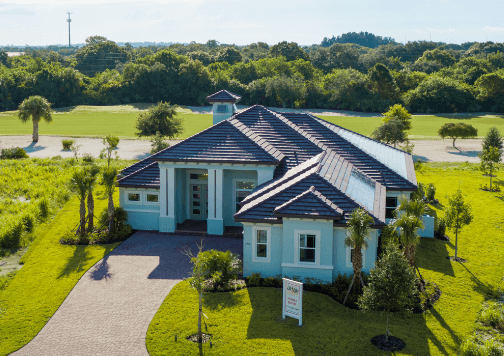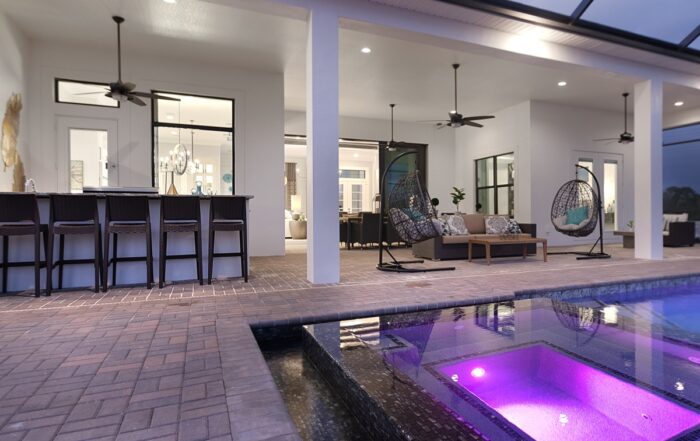LifeStyle Solar Homes
WHAT ARE LIFESTYLE SOLAR-POWERED HOMES?
LifeStyle solar-powered homes represent the cutting-edge clean-energy homes we’re building today. Taking LifeStyle SunSmart homes to a whole new level, LifeStyle solar-powered homes are equipped with photovoltaic (PV) technology that captures free sunlight and converts it into free electricity. So much electricity, in fact, that oftentimes your energy bills will be significantly slashed.


HOW IT WORKS
Photovoltaic panels, oftentimes referred to as solar panels, will capture the power of the sun and convert it to direct-current (DC) electricity. A power inverter then converts the DC electricity into regular alternating-current (AC) electricity – the type of electricity needed to power your home.
If your LifeStyle solar-powered home produces more energy than you need, this surplus of energy will be routed to your utility company, which will then credit your utility account for the excess energy. When the sun isn’t shining, like on cloudy days or at nighttime, you will use this credit to purchase energy from your utility company. This give and take of energy is called “net-metering” and it happens seamlessly and automatically.
SOLAR PANEL MOUNTING
Whether your home has a shingle, tile, or metal roof will determine the type of solar panels appropriate for your home.
Homes with a shingle or metal roof will be equipped with “rack-mounted” panels. Each panel will be equipped with its own micro-inverter, which allows the entire system to continue to perform optimally should an individual panel malfunction. Rack-mounted panels allow air to circulate freely, which keeps operating temperatures lower during warm summer days, ultimately aiding in longevity.
Homeowners with a tile roof have the option to choose “integrated” solar panels. In this case, the solar panels will be integrated into your roof, actually taking the place of certain tiles for a pleasing architectural appearance.
Whether your solar panels are integrated or rack-mounted, the sensitive photovoltaic cells will be protected by a tough polycarbonate covering strong enough to stand on. These units are sturdy, and they will stay put even if the wind blows vigorously, as it sometimes does in Florida.


MICRO-INVERTER TECHNOLOGY
Micro-inverter technology is a solar advancement that utilizes small power inverters mounted to each solar panel so that the direct-current (DC) to alternating-current (AC) conversion takes place right where the power is being generated. The major advantage of micro-inverter technology is that if the power output of one solar panel were to become lower, because something shielded part of it from the sun, for example, only that solar panel’s power would be reduced. All other solar panels would continue to produce at full capacity. (Note: Micro-inverter technology is not available for integrated systems.)
ACHIEVING A ZERO-ENERGY PERFORMANCE
When a home produces as much energy as it consumes on a yearly basis, it has achieved a zero-energy performance.
In August 2010, with the guidance of the world-class scientists at the Florida Solar Energy Center, LifeStyle Homes proudly built the first solar-powered zero-energy home on Florida’s East Coast. This home, the St. Croix model (which sold before it was completed), was built in Capron Ridge, Tralee Bay Estates in Rockledge, Florida. It went on to win numerous awards, including the Florida Home Builders Association (FHBA)’s Aurora Award for the best solar-energy home, as well as the North American Net-Zero Energy Production Home of the Year, awarded by the Net-Zero Energy Home Coalition in Canada.
Since that time, LifeStyle Homes has built many more zero-energy homes right here in Brevard and Indian River counties. And because all LifeStyle homes are built to such tight energy-efficiency standards, our zero-energy homes require less solar panels than oftentimes needed to achieve a zero-energy performance.


FEDERAL TAX INCENTIVES
Owners of solar-powered homes may qualify for numerous federal tax incentives, including the Federal Residential Renewable Energy Tax Credit equal to 30% of the solar system’s retail cost (updated for 2022 – 2032). That means that if your solar system retails for $20,000, the federal government will issue you a tax credit of $6,000, making the actual cost of your solar system $14,000.
Be sure to check with your financial advisor on all financial incentives before purchasing a solar system.
THE BENEFITS OF BUILDING A SOLAR-POWERED HOME
Consider this quick recap of the benefits of building a LifeStyle solar-powered home.
- Energy bills are significantly slashed. And, if your solar-powered home produces more electricity than needed, your utility company will credit your account for the surplus.
- Owners of solar-powered homes may qualify for numerous federal tax financial incentives, including the Federal Residential Renewable Energy Tax Credit equal to 30% of the solar system’s retail cost (through 2032).
- Solar power helps the United States gain freedom from the tyranny of foreign oil. As energy is generated by the sun that shines on the United States, our country’s dependence on oil imports is significantly lessened. Not only does this mean increased safety for the United States, it also means more economic stability for all Americans.
- Solar power provides our planet relief from excessive greenhouse gas emissions. Unlike fossil fuels, the technology requires no carbon, methane, or particulate emissions, nor does it call for significant drilling or mining operations.
- The clean-energy revolution is upon us. Solar-powered homes have the ability to make all public-utility dependent homes obsolete. Building a LifeStyle solar-powered home today means that your home will be ready for what the future may bring.





